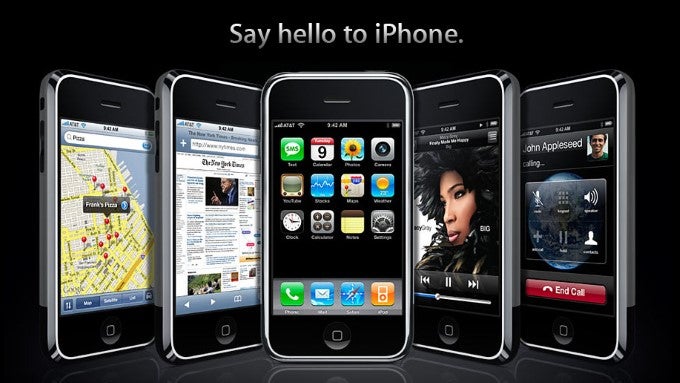These were the best phones... before the iPhone

To better understand how much of a change it brought, here are the best phones available right before the original iPhone:
BlackBerry Curve 8300

Then, it improved on this winning formula with the BlackBerry Pearl, a more compact phone and also its first with a camera, as well as a new trackpad for navigation, but its last major device before the iPhone was actually the Curve.
The BlackBerry Curve was more powerful and featured a higher resolution, but its flaws truly became obvious with the arrival of the iPhone, which had a vastly superior and more comfortable user interface.
Nokia N95

Nokia was not quite as addictive as 'CrackBerries' at the time, but it was the world's biggest phone maker with no competitor in sight and its N95 was a powerhouse. The Finnish phone maker made all sorts of phones in various shapes, sizes and prices, and the N95 featured a truly amazing camera and it supported a fast 3G connection. Unfortunately that was it: everything else on the N95 was ages behind the innovative iPhone. The experience was much inferior, with no proper way to render web pages and a keyboard that was much slower for those who wanted to actually do things on their phone.
Palm Treo 650

Sure, it was not a pretty thing (especially with that stick out antenna), and it was definitely on the chubby side, but it had the advantage of a physical keyboard on board and a cool D-pad for navigation.
The phone ran on the custom Palm OS which was its bread and butter. The system featured a calendar, an email client, calculator, world clock and other features, and it was so advanced that some reviewers advised consumers to 'throw that cell phone away, better yet throw away your PDA and MP3 player, too'.
Samsung BlackJack

The iPhone, however, was even thinner and that was particularly impressive to early reviewers. Among its key highlights were support for Bluetooth 2.0 and push e-mail, but like many other phones of that time it lacked Wi-Fi connectivity.
The BlackJack ran Windows Mobile 5.0, and even got updated to Windows Mobile 6, but this only sounded good pre-iPhone. Shortly after the iPhone launch, the BlackJack seemed terribly obsolete and clunky.
Sony Ericsson K800i

Sony Ericsson was known to make phones with great cameras. The Sony Ericsson K800i was both elegant for the times and it features a 3-megapixel camera with a powerful Xenon flash that delivered industry-leading results. The K800i was the first device branded as a 'Cyber-shot' camera phone, and also the first ones with a powerful new graphics engine that would make possible to have full 3D Java games.
Motorola RAZR

It could brag about its sleek flip-out design that seemed every bit as futuristic as tech gadgets went. Similarly to the iPhone, the original silver RAZR V3 launched on Cingular (later to become AT&T) only for a similarly pricey $500.
At just half an inch thick and with a body weighing an airy 3.3 ounces, it was distinctly different than other phones of the time. Interestingly, the V3 was a rather average phone in terms of specs: it only had a VGA camera that could not record video in the beginning. Which reminds us of...
...Apple's iPhone
"iPhone combines three products — a revolutionary mobile phone, a widescreen iPod with touch controls, and a breakthrough Internet communications device with a desktop-class email, web browsing, maps, and searching — into one small and lightweight handheld device."
The original iPhone was the thing that started it all for modern smartphones: while there were smartphones before it, they were nothing like Apple's iPhone that trumped them with its radically bigger screen, mind-boggling multi-touch interface, and the first on-screen keyboard that actually worked well.
The list of break-through innovations in the original iPhone is long and involves so many stories that new books only now start to shed light on some of its details. Here is a short summary of what made the iPhone so special:
- iOS, a revolutionary new multi-touch interface controlled entirely with your fingers
- Gigantic for the times 3.5-inch display with a resolution of 320 x 480 pixels
- Completely new on-screen keyboard
- Internet Connectivity (Wi-Fi, but only 2G cellular) with native email client and web browser
- 2-megapixel photo camera (but with no video recording capabilities)
- Ambient light sensor, proximity sensor
- 4GB / 8GB / 16GB storage models
- YouTube and Google Maps applications, Google Search
- iPod music / video player with support for iTunes
Follow us on Google News









![A new Android bug is making it impossible to install new apps. Are you affected? [UPDATE]](https://m-cdn.phonearena.com/images/article/176703-wide-two_350/A-new-Android-bug-is-making-it-impossible-to-install-new-apps.-Are-you-affected-UPDATE.webp)

Things that are NOT allowed:
To help keep our community safe and free from spam, we apply temporary limits to newly created accounts: